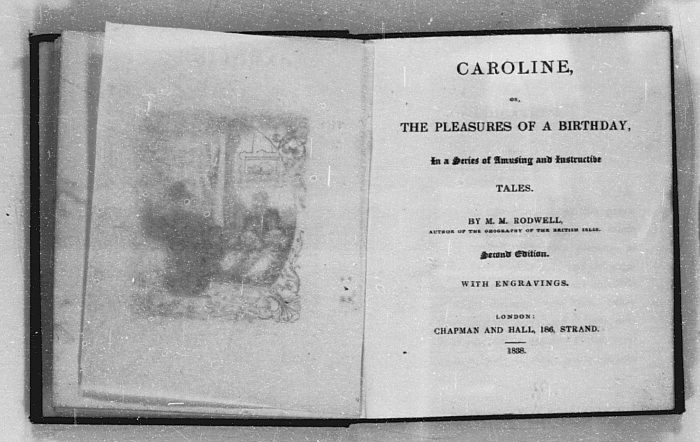Stories Before 1850. 0202: Mary Martha Rodwell, Caroline, or, The Pleasures of a Birthday
| Author: |
Rodwell, Mary Martha |
| Title: |
Caroline, or, the pleasures of a birthday, in a series of amusing and instructive tales. By M. M. Rodwell, author of The Geography of the British Isles. Second edition. With engravings |
| Cat. Number: |
0202 |
| Date: |
1838 |
| 1st Edition: |
1835 |
| Pub. Place: |
London |
| Publisher: |
Chapman and Hall, 186, Strand |
| Price: |
Unknown |
| Pages: |
1 vol., 141pp. |
| Size: |
13 x 10 cm |
| Illustrations: |
Frontispiece plus five further engravings |
| Note: |
From page 99 to end missing from digitisation |
Images of all pages of this book

Introductory essay
Mary Martha Rodwell was the author of The Geography of the British Isles (2 vols., 1834) and The Spoiled Child Reclaimed; or, The Advantages Arising from Good Instruction (1835) as well as Caroline, or the Pleasures of a Birthday (1835, rpt. 1838). What little biographical information is available has to be gleaned from her preface to her geography text book. She wrote this first book, she recorded, during a period of 'severe infliction which confined me to my chamber nearly three years'. Her motive for writing was the pecuniary embarrassment of her parents (The Geography of the British Isles, 1: vii and iii). Presumably she succeeded is alleviating their plight, for the book had an impressive subscription list, including 'Her Royal Highness the Princess Victoria', who would become queen three years after its publication.
Caroline, or the Pleasures of a Birthday is really a series of seven cautionary tales inset within a brief framing narrative (these separate tales are listed on the contents page). It is Caroline's tenth birthday. She is envious of the freedom enjoyed by her older sister, Jane, and she wishes that she too could govern her own life rather than being told what to do. Their mother, Mrs. Somers, announces that Caroline is to have a holiday because it is her birthday, and asks Caroline how she wishes to spend the day. Caroline asks that her mother tell her and Jane some stories, which, after an initial prayer, Mrs. Somers is happy to do. The tales recount the good deeds of some children and, more often, the errors of others. After each one, Mrs. Somers offers a few words to explain the moral of the story. This was a format common in children's literature, used, for instance, by Sarah Fielding in The Governess (1749) and by Thomas Day in Sandford and Merton (1783-89).



